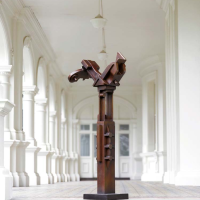48. ROBERT KLIPPEL

Robert Klippel had many wonderful ideas; one of the best was to treat man-made mechanical and industrial objects as if they were produced by Nature. The truly Modern sculptor, he thought, should be always interested in three-dimensional form no matter its source.
As long ago as 1945, Klippel wanted to discard the human figure from its traditional and predominant place in sculpture. The great English sculptor Henry Moore (1898-1986) tended to relate the human figure to Nature; Klippel wanted to relate the mechanical to Nature and to align her with the machinery of an industrial world.
Since his time in Paris, Klippel always understood that the point of Modernism was to add new forms to the world of reality rather than replicate them a new world called for new forms. As he famously put it, he wanted to seek the relationship between the cogwheel and the bud. The justly famous Australian art critic Robert Hughes claimed that Klippel possessed the pure will to form. Always, in sculptures such as his Opus 421 (b) of 1983 the inorganic is made to grow like the organic.
Klippel died in Sydney in 2001 on his eighty-first birthday after almost sixty years of artistic output. He was a gentle and quiet man who shunned publicity and generally was not as well-known as he deserved. Nonetheless, he was deeply respected and held in very high regard by the art world, especially in Sydney, and in 2002 he was the subject of a very successful retrospective, entitled Robert Klippel: A Tribute Exhibition, at the Art Gallery of New South Wales.
The present bronze sculpture, Opus 421 (b) of 1983, was cast from the original painted wood assemblage of the same title in a very limited edition of six identical works, progressively from 1981.1 The casting was carried out by Peter Morley AO at the Meridian Foundry in the Melbourne suburb of Richmond in 1989.
Klippel was not at all curious about mechanical functions; but he was very much fascinated by mechanical forms. For him, after the mid-Eighties, mechanical and industrial objects or machines and their component parts came to have an even greater visually compelling appeal. This was especially the case after the success of his first major commission in bronze: a Federal Government funded public sculpture group for the opening of the National Gallery of Australia in Canberra, which was formally inaugurated by Her Majesty Queen Elizabeth II on 12 October 1982. The present work was created during this focal period.
Klippels Opus 421 (b) of 1983 was initially constructed from sections of pre-fabricated wooden pattern parts that the artist had found in 1964 and stored for the following seventeen years. Klippels development from wood assemblage to bronze cast sculpture during the early to late Eighties extended the parameters of re-use and recycling to an artistic form of upcycling where found and pre-fabricated objects were technically remade and materially transmuted. Bronze casting allowed Klippel to push his wooden assemblage works toward a new cohesive unity, in a material that withstood the outdoors.
The incorporation of new unity of form may be seen to good effect in Opus 421 (b) in that the constructional sculpture not only adds new forms to the world of reality, but also displays an upwardly thrusting visual movement that leads to a forked branch-like structure. Certainly, its composition takes on a crucifixion format or reminds the viewer of the support structures of a Shinto temple. To Klippel these would inappropriate readings, since his aim was to allow the viewer to re-appraise the beauty of mechanical forms as legitimate elements in a new three-dimensional harmony.
Klippels Opus 421 (b) of 1983 is a hallmark bronze that typifies the artists refinement of the visual language of massed silhouetted shapes during the mid to late Eighties.
Menzies Art Brands Note:
Dr. Ken Wach wrote the catalogue for the exhibition Robert Klippel: The American and European Years at Galerie Gmurzynska in Zrich in June 2013 where he gave an address at the exhibition opening at the Baur au Lac Hotel in Zrich the first Klippel exhibition in Europe for sixty-three years. The Robert Klippel Estate is internationally represented by Galerie Gmurzynska, Switzerland.
Footnote:
1. Artists note in Robert Klippel Recent Sculpture & Works on Paper, exhibition catalogue, Watters Gallery, Sydney, 15 November -10 December 1983, u.p., (p.6.)
Literature
Edwards, D., Robert Klippel: Large Wood Sculptures and Collages, Art Gallery of New South Wales, Sydney, 1995
Edwards, D., Robert Klippel, Art Gallery of New South Wales, Sydney, 2002
Gleeson, J., Robert Klippel, Bay Books, Sydney, 1983
Hughes, R., Art in Vogue. Robert Hughes Writes on Robert Klippel, Vogue Australia, Sydney, November-December, 1963
Hughes, R., Robert Klippel, Art and Australia, vol. 2, no. 1, Sydney, May, 1964
Lynn, E., When Whimsy is Strangled by Scrap Metal Monumentality, The Bulletin, Sydney, 1 March, 1969
Scarlett, K., Australian Sculptors, Nelson, Melbourne, 1980
Scarlett, K., Robert Klippel: Australias Greatest Sculptor, Sculpture, vol. 23, no. 3, April, 2004
Wach, K., Robert Klippel: The American and European Years, Galerie Gmurzynska, Zrich, 2013
Wach, K., Robert Klippel: Opus 995 of 1998, Galerie Gmurzynska, Basel Art Fair Miami, Florida, 2013
Associate Professor Ken Wach
Dip. Art; T.T.T.C.; Fellowship RMIT; MA; PhD,
Former Principal Research Fellow and Head of the School of Creative Arts,
The University of Melbourne.